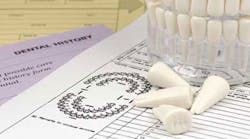Thursday Troubleshooter: Is there a proper dental code for interim fillings?
Do you have a tough issue in your dental office that you would like addressed? Each week the experts on Team Troubleshooter will tackle those issues and provide you with answers. Send questions to [email protected].
QUESTION: What code should be used for an interim filling designed to help a patient get by until definitive treatment can be performed? For example, perhaps a patient is in full ortho. The doctor would like to place a temporary filling in an area of decay at the margin of a crown so that she can wait until the braces are off to replace the crown. If we charge it as a D2391, the crown will later be denied due to frequency limitations on restorative procedures. She isn’t in pain, so a sedative filling or palliative treatment doesn’t seem to be accurate coding. Is he supposed to do this filling for free in order to be reimbursed for the crown?
ANSWER FROM PATTI DIGANGI, coauthor of the “DentalCodeology" series of books:
Interim Care Coding—For a majority of dental practitioners, the most frequent thought when there is dental breakdown is how it can be fixed. There are interim steps that are often the better choice in some situations. Atraumatic Restorative Treatment (ART) was first used in the 1990s in third world countries and was officially endorsed by the World Health Organization (WHO) in 1994. The two main principles of ART are 1) the removal of gross carious tooth tissues using hand instruments only, and 2) restoring the cavity with a restorative material that sticks to the tooth. ART is currently performed using glass-ionomer as the restorative material. Glass ionomer acts as a physical barrier against biofilm/pH destruction and can be recharged with fluoride releasing into the adjacent enamel. This procedure is temporary and not particularly attractive, yet has the benefit of protecting both oral and systemic health outweighs the esthetics.
The American Academy of Pediatric Dentistry has written a policy statement that states, “When circumstances do not permit traditional cavity preparation and/or placement of traditional dental restorations or when caries control is necessary prior to placement of definitive restorations, interim therapeutic restorations (ITR) may be beneficial and are best utilized as part of comprehensive care in the dental home.”
ART and ITR are basically the same procedure. The difference is whether the tooth being treated is deciduous (ITR) or permanent tooth (ART). There are two codes that can fit this situation. A code for ITR was added to CDT in 2014 for deciduous teeth:
D2941 interim therapeutic restoration: primary dentition—Placement of an adhesive restorative material following caries debridement by hand or other method for the management of early childhood caries. Not considered a definitive restoration.
What if, as in the case mentioned here, it is a permanent tooth? There is a code that some will recognize and remember its old definition. Yet in the world of evolving codes, this code has been given nomenclature (name) and updated definition.
D2940 protective restoration—Direct placement of a restorative material to protect tooth and/or tissue form. This procedure may be used to relieve pain, promote healing, and prevent further deterioration. Not to be used for endodontic access closure, and as a base liner under restoration.
The applicability of this code for this situation can clearly be seen. Both are temporary and should not create problems when further and more definitive care is completed. These codes are the most accurate codes describing the care rendered. Of course, policies are different than coding.
ANSWER FROM KYLE SUMMERFORD, editor of Dental Assisting & Office Manager Digest, and founder ofDDSGuru.com:
Great question! Based on the example you provided, the more accurate code to use would be D2940, Protective Restoration. The D2940 code is no longer described as a sedative filling as it was updated back in the CDT 2015. Reporting D9110 would be incorrect unless the patient arrived at your office in pain.
Regarding being paid twice, D2940 Protective Restoration can sometimes be considered by the insurance company and paid once in a lifetime per tooth. Also keep in mind that if this procedure is paid by the insurance company, the insurance company can later deduct the amount paid for the protective restoration from the crown fee that will be paid at a later date. As always, narratives go a long way when pleading your case to the insurance company because sometimes the CDT descriptor doesn’t always tell the whole story.
Good luck! For more coding tips and tricks, follow my monthly coding column, "Coding with Kyle,” featured in Dental Assisting and Office Manager Digest.
RECENT THURSDAY TROUBLESHOOTERS:
Dental assistant not getting hours she was promised
Dentist couple needs guidance about opening new practices
Gum-smacking dental team member
Send your questions for the experts to answer. Responses will come from various consultants, many of whom are associated with Speaking Consulting Network, Academy of Dental Management Consultants, Dental Consultant Connection, and other expert dental support organizations. Their members will take turns fielding your questions on DentistryIQ, because they are very familiar with addressing the tough issues. Hey, it's their job.
Send your questions to [email protected]. All inquiries will be answered anonymously every Thursday here on DIQ.







